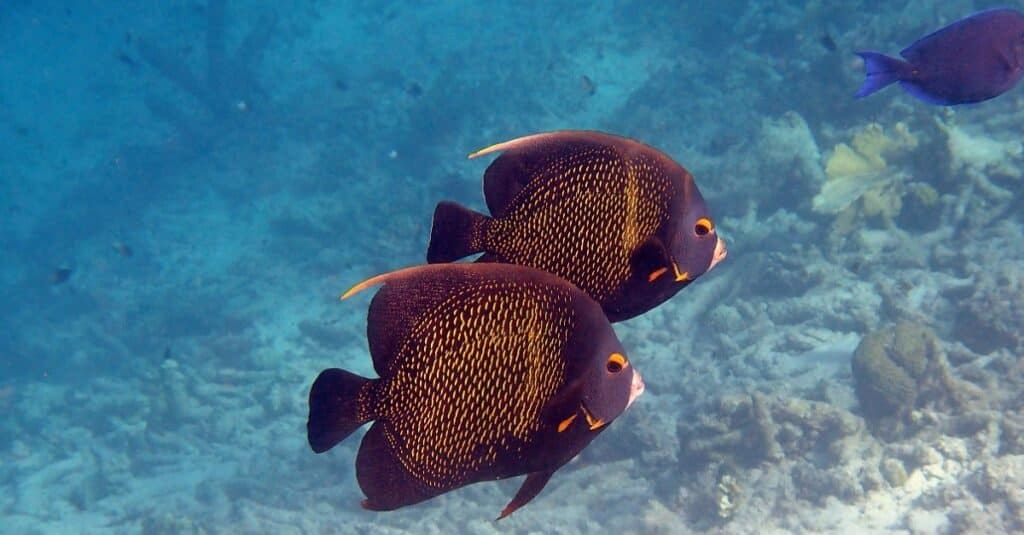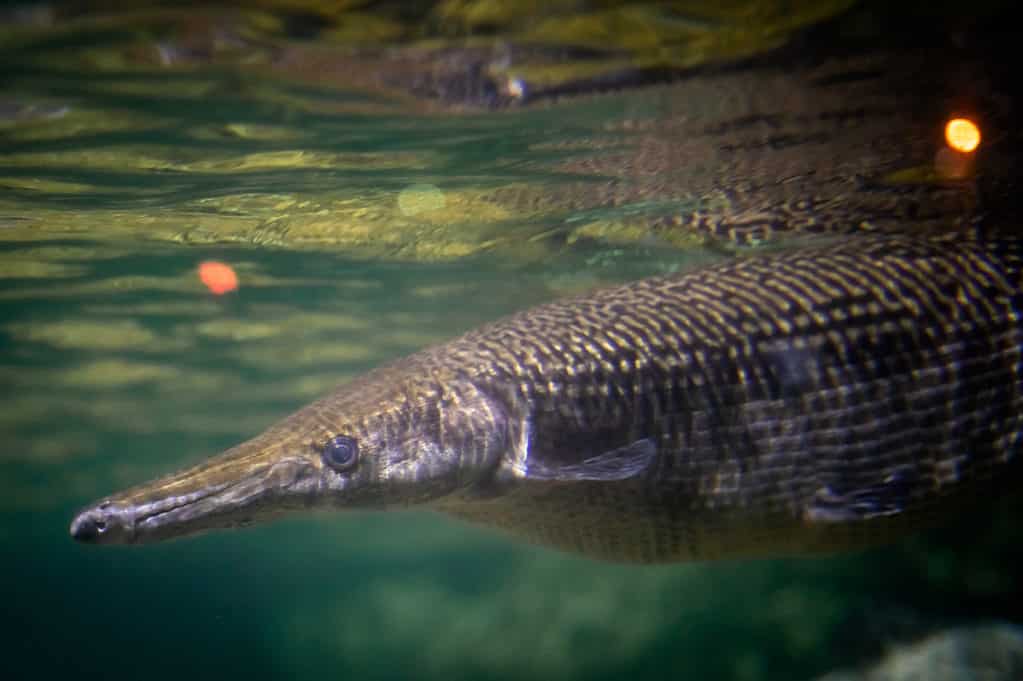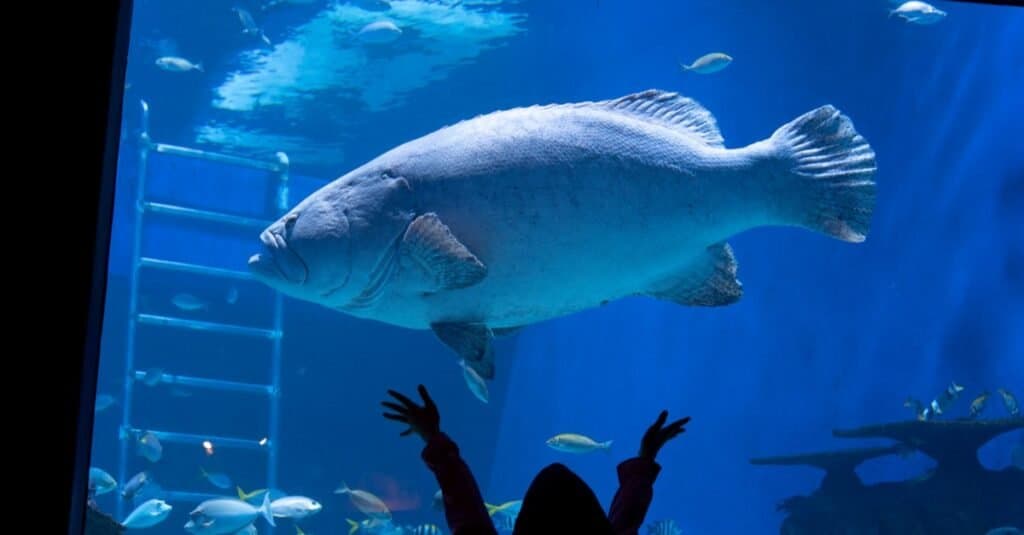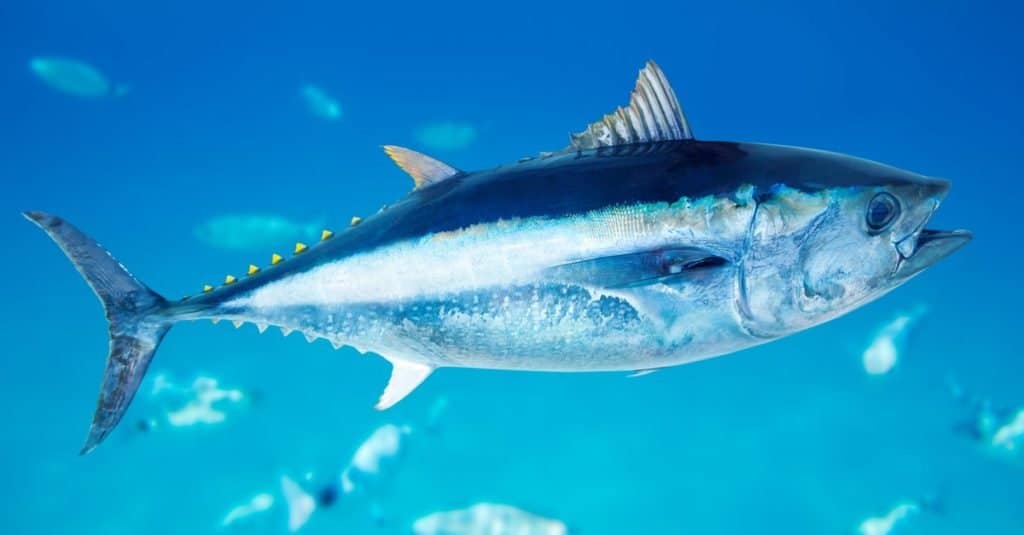Cuba is a large island nation south of Florida and east of Mexico’s Yucatán Peninsula. With a population of 11 million, it has the second highest population of all the Caribbean countries. As an island country, fish are important for the economy both for commerce and local cuisine. Some delicious Cuban-style fish dishes include sautéed fish with tomatoes, garlic, onions, and other herbs and spices. There are many types of fish found in the oceans around Cuba. Keep reading to learn more about 7 spectacular fish in Cuba!
1. French Angelfish
The French angelfish is found in the ocean surrounding Cuba and other Caribbean nations. These fish generally swim around in pairs with their mate. They eat aquatic plants and invertebrates, and young French angelfish eat parasites off of larger fish and live in and around coral reefs. They have thin bodies that make them hard to see from the front. However, from the side, they have beautiful gold markings that are easy to spot. Young French angelfish are often more colorful than adults. This fish is not sold for food, but it is sometimes caught for aquariums. In aquariums, they can grow up to 16 inches long.

©iStock.com/sujesh80
2. Cuban Gar
This freshwater fish in Cuba is known locally as the manjuari. It is found only in rivers and lakes in Cuba. Perhaps partially because of this small range it has become critically endangered. Other factors in their declining numbers include overfishing and habitat loss. Additionally, the smallmouth bass was introduced in some areas and eats young Cuban gar, preventing them from reaching adulthood.
The flesh is commonly eaten in Cuban cuisine, but avoid the eggs — they are poisonous for humans! The average Cuban gar is around 3 feet long, but they can grow up to 6 feet long. These fish are unique because they can tolerate water with high levels of ammonia and nitrate, and they are also fairly resistant to diseases. They generally eat fish and birds.

©iStock.com/Siraj Ahmad
3. Lucifuga Fish
There are several species of lucifuga fish in Cuba. They live in caves and sinkholes that have freshwater or brackish water (a mixture of fresh and saltwater). These fish are quite unique and have adapted to living in the dark. The Lucifuga fish that live in Cuba’s dark underwater places have changed so much that they almost don’t have any color. They also have no eyes and look a bit frightening to some people. This rare fish is an endangered species according to the International Union for Conservation of Nature.
4. Goliath Grouper
The goliath grouper gets its name because it is the largest grouper species and one of the largest of any bony fish species. It used to be known as the “Jewfish.” Experts believe this is because its face and body resemble some unfavorable anti-Semitic stereotypes.
These giant fish in Cuba can grow to be up to 8 feet long and weigh up to 800 pounds. They are vulnerable to population declines due to their lifecycle habits. Young goliath groupers stay in mangrove nursery habitats for 5 to 6 years and come together in large groups to spawn each year. When they spawn they are easy to catch in the group. Additionally, mangrove habitats are on the decline, meaning there is less habitat for young goliaths to stay in until they reach adulthood. The goliath grouper was listed as critically endangered but in 2021 its status was changed to vulnerable, which is a more favorable position.

©eril Victory/Shutterstock.com
5. Marlin
Two marlin species, the white marlin and the blue marlin, can be found in the waters outside of Cuba. The largest white marlin ever found was 9.2 feet long and weighed 181 pounds. The largest blue marlin ever found was 16 feet long and weighed over 1,800 pounds. So, the blue marlin is quite a bit larger on average, but both species are quite a catch. Both of these marlin species are billfish. They have a long pointed nose or snout that may resemble a sword or spear.
Even though white marlin are not listed as endangered in any way, there are some regulations regarding fishing for them. After being caught, a white marlin must be released back into the water. Before you release it, you have to keep it boat-side in the water to ensure it has a good chance of survival after release. Blue marlins, which are listed as vulnerable to extinction, must also be returned to the water after being caught.

©Neophuket/Shutterstock.com
6. Swordfish
Swordfish are another type of billfish with an exceptionally long, flat, and pointed snout, giving them their name. They use this “sword” to injure and slow down their prey to make it easier to catch. They may also use it as a defense against predators. Also helping the swordfish to catch prey is its sheer speed. According to some sources, they can reach speeds of up to 60 miles per hour. However, that is unverified. Experts believe a speed of 22 miles per hour is more realistic, which is still quite fast for such a large fish.
Swordfish commonly grow to be at least 10 feet long. The largest one ever found weighed over 1,000 pounds. Because of their size, their flesh is often sold as “steaks”. They are considered a “near threatened” species but conservation efforts in some areas have been successful in helping the population to rebound. A common way to serve swordfish in a Cuban style is with fresh tomato salsa.

©SVITO-Time/Shutterstock.com
7. Tuna
There are several species of tuna that can be caught in the ocean around Cuba including:
- Yellowfin tuna
- Bluefin tuna
- Bigeye tuna
- Blackfin tuna
Because of overfishing, it is now popular to grow some species of tuna, especially bluefin tuna, in fish farms. This type of fish is considered a delicacy in some places. It can be eaten raw or cooked and can be sold frozen or fresh. Canned tuna fish is also a huge market, especially in Australia and the United States.
Each of these tuna species is somewhat different from the others, but they all have a few things in common. They have sleek bodies, they are fast swimmers, and they have a dorsal fin and a pelvic fin that can fold down when they are swimming fast. Their tails are shaped like a crescent moon, and they have between seven and ten “finlets” that run between the dorsal fin and the tail. One unique thing about tuna compared to other fish is that they are able to maintain a warmer body temperature than the water around them.

©lunamarina/Shutterstock.com
Up Next:
- 10 Sharks Found in the Caribbean Sea
- Discover the 12 Most Beautiful Islands in the World
- Types of Pet Fish That Live Long
- Cuban Trogon: The National Bird of Cuba
The post Discover 7 Spectacular Fish Found in Cuba appeared first on AZ Animals.
from Animal News, Facts, Rankings, and More! - AZ Animals https://ift.tt/6XAIoUE